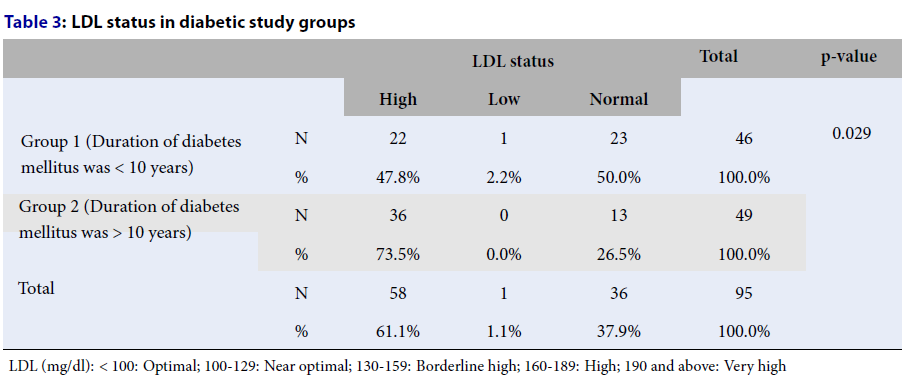Diabetic dyslipidemia: A screening tool for cardiovascular risk assessment
DOI:
https://doi.org/10.15419/bmrat.v8i12.713Abstract
Introduction: Dyslipidemia is the most common threat in connection to developing cardiac disorders in type two diabetes mellitus. It has a role in the eventual development of atherosclerosis and increased mortality and morbidity. The present study was conducted to determine the lipoprotein abnormalities found in type two diabetic patients in the Mangalore region in South India.
Methods: A cross-sectional study was conducted involving 95 types two diabetic patients. A fasting venous blood sample was obtained from these patients. The levels of different lipoproteins were estimated using the VITROS 5600 automatic analyzer. The patients were divided into two groups for comparison based on their duration of diabetes mellitus. The statistical tools used were the independent t-test for the comparison of the means of both quantitative variables and the Chi-square test for the proportion comparisons. The statistical package used was the Statistical Package for Social Sciences (SPSS) version 22.
Results: According to the results of this study, deranged lipid profile levels were seen in most of the diabetic patients in group two. It was observed that about 67.3% of the patients in group 2 had higher serum cholesterol levels while a relatively lower number had a high level of cholesterol in group one. There was a significant (p-value of < 0.001) association between the two groups. There was an insignificant association between diabetes mellitus and high-density lipoprotein levels. In this study, triglyceride levels were also very high in most of the diabetic patients (p-value of 0.003), further increasing the risk of obesity and metabolic syndrome. Very low-density lipoprotein and low-density lipoprotein levels were also significantly increased with a significant p-value.
Conclusion: Most diabetic patients tend to have dyslipidemias. Screening them for dyslipidemias may be useful to prevent insulin resistance, atherosclerosis, and metabolic syndrome. Drugs like statins inhibit the rate-limiting step of cholesterol biosynthesis, leading to a lower blood cholesterol. This may help to normalize their lipid profiles and to prevent severe adverse outcomes like coronary artery disease and stroke in diabetic patients. A healthy lifestyle and dietary modifications may also help to promote good health in the patients with diabetes mellitus.

Published
Issue
Section
License
Copyright The Author(s) 2017. This article is published with open access by BioMedPress. This article is distributed under the terms of the Creative Commons Attribution License (CC-BY 4.0) which permits any use, distribution, and reproduction in any medium, provided the original author(s) and the source are credited.
